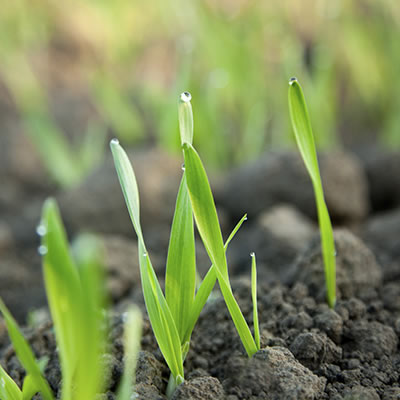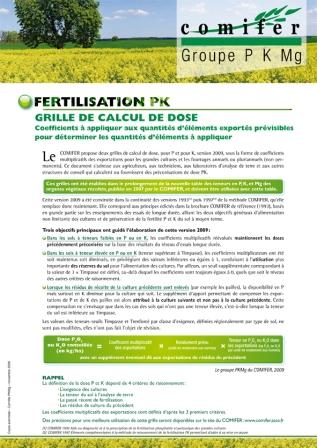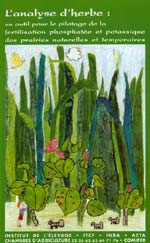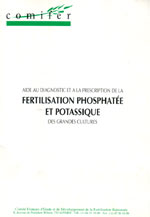The COMIFER PKMg Group has about fifty members (27% research and education, 40% development, 33% agricultural supplies), including twenty who are particularly active. It meets twice a year to take stock of scientific advances, share information and referrals, establish or update the rules and references of good fertilization practices.
 The past work of the group led to the defining of the modes of reasoning bases currently used in France, primarily the PK COMIFER grid and tools derived from the same concepts (RegiFert, …).
The past work of the group led to the defining of the modes of reasoning bases currently used in France, primarily the PK COMIFER grid and tools derived from the same concepts (RegiFert, …).
The group also integrates the concerns of water protection against the risk of eutrophication, which requires good management, adjusted to the mineral and organic input needs of crops.
It also focuses on the evaluation of fertilizing qualities of new products or by-products appearing in agriculture (derived from the treatment of effluent or waste, industrial by-products, …) from the perspective of nutrient recycling to save mining resources.
It allows you to share information or references related to the management of the resource, the regulation of fertilizers, and the economic environment.
Finally, it focuses on defining new approaches to nutrient bioavailability: new analytical methods and renovation of sustainable fertilizing.
COMIFER Membership and group participation provides first access and completeness of information on the work of the group.
For all contact: Christine LE SOUDER, group leader.
Nutrients PK and Mg
The COMIFER PKMg group is interested in phosphorus (P), potassium (K) and magnesium (Mg).
 These three nutrients, needed by crops, have the common characteristic that their natural forms are in close interaction with the solid phase of the soil, meaning their availability to crops will largely depend on soil properties.
These three nutrients, needed by crops, have the common characteristic that their natural forms are in close interaction with the solid phase of the soil, meaning their availability to crops will largely depend on soil properties.
The annual flow of absorption by crops, and even more so, by export crops, are relatively small compared with the total stock of the ground. But only part of the total stock is bioavailable, a large part being included in some minerals at low to very low solubility in the short term. Their root absorption occurs in liquid phase,within this single bioavailable fraction.
The behavioral similarities of these elements in the functioning of soil-plant systems is what lead to P, K and Mg being treated in the same thematic COMIFER group, in order to abide by similar rules of good management of crop fertilization and soil fertility.
Phosphorus, potassium and magnesium are elements whose dynamics have been the subject of much reasoning over several years, taking into account the progressive development of mineral and organic soil stocks.
P, K or Mg deficiencies in crops, now relatively rare in France, following the significant fertilization performed in the 20th century, are likely to occur or recur but very gradually; also the reasoning on P, K and Mg nutrition of crops is often seen as secondary after that of N nutrition. It is nevertheless true that these elements can be limiting and poorly balanced crop nutrition leads to inefficient use of inputs.
Conversely, the risk of over-fertilization with P are important in context of strong livestock manure surplus. The transfer of P to surface water can lead to eutrophication, it is important to adapt the supply of P to crop needs, within the framework of agricultural practices avoiding losses to the environment.
Publications of the PKMg Group
Help with the diagnosis and the prescription of phosphate and potassium fertilization of field crops (1995)
This document compiles and organizes existing bases that aid in the diagnosis and the prescription of phosphate and potassium fertilization of field crops …
28 pages
Additional elements for the PK fertilization reasoning method to assist in its implementation (1997)
This document provides additional information to the first brochure, offering concrete evidence to assist with practical implementation (effluent inputs, proposal to charts, grid adaptations), arguments to facilitate appropriation (evolution speeds of the contents) and the recommendations of two other European countries.
49 pages

PKMG Computing Grid and table of exports
Get the complete computing grid PKMg 2007 and 2009 Versions
The Co-published Brochures

Grass analysis: a tool for control of phosphate and potassium fertilization of natural and temporary grassland
Institut de l’Elevage – ITCF – INRA – ACTA – Chambres d’Agriculture 22.25.62.63.64.71.76 – COMIFER
A better reasoned phosphate and potassium fertilization on more than 10 million hectares of grassland, …
Gilles THEVENET – Former President of COMIFER
The proceedings of the COMIFER-GEMAS conference
Denoroy, Pascal, Christine Le Souder, Jean-Claude Fardeau. 2005. “Understanding the functioning of agro-ecosystems to adjust the supply of phosphorus, potassium and magnesium to crop needs.” Coll. COMIFER-GEMAS, Blois, in November 2005,
Selected Bibliography (not exhaustive)
- Badey, Laureen, Natie Lahitte, Francis Flenet, and Fabrice Bosque. 2013. “French Environmental Communication on Sunflower and Rapeseed Oils Based on Life Cycle Assessment.” OCL 20 (4): A401. doi:10.1051/ocl/2013004.
- Baize, Denis. 2000. Guide des analyses en pédologie. 2eme édition revue et augmentée. Techniques et Pratiques. INRA Edition.
- Bélanger, Gilles, Annie Claessens, and Noura Ziadi. 2011. “Relationship between P and N Concentrations in Maize and Wheat Leaves.” Field Crops Research 123 (1): 28–37. doi:10.1016/j.fcr.2011.04.007. 2012. “Grain N and P Relationships in Maize.” Field Crops Research 126 (0): 1–7. doi:10.1016/j.fcr.2011.09.016.
- Bodet J.-M., Hacala S., Aubert C., and Texier C. 2001. Fertiliser avec les engrais de ferme. Institut de l’Elevage, ITAVI, ITCF, ITP. Paris.
- Bouthier, Alain, Christine Le Souder, and Pierre Castillon. 2007. “Quels seuils diagnostiques pour gérer la fertilisation magnésienne des cultures annuelles ?” In Blois : COMIFER, Paris.
- Bui, Elisabeth. 2013. “C:N:P Stoichiometry in Australian Soils with Respect to Vegetation and Environmental Factors – Springer.” Plant Soil. doi:10.1007/s11104-013-1823-9. http://link.springer.com/article/10.1007/s11104-013-1823-9/fulltext.html.
- Cakmak, Ismail. 2013. “Magnesium in Crop Production, Food Quality and Human Health – Springer.” Plant Soil 368: 1–4. doi:10.1007/s11104-013-1781-2.
- Colomb, B., P. Debaeke, C. Jouany, and J.M. Nolot. 2007. “Phosphorus Management in Low Input Stockless Cropping Systems: Crop and Soil Responses to Contrasting P Regimes in a 36-Year Experiment in Southern France.” European Journal of Agronomy 26 (2): 154–65. doi:10.1016/j.eja.2006.09.004.
- Colomb, B., L. Fontaine, A. Glandières, A. Aveline, M. Carof, F. Celette, D. Craheix, J. Arino, S. Collet, and J. F. Garnier. 2014. “Une Approche de La Durabilité Des Systèmes de Grandes Cultures Biologiques Spécialisés.” Accessed March 3. http://www.sfer.asso.fr/content/download/3816/33388/version/1/file/COLOMB.pdf.
- COMIFER groupe PK. 1997. “Éléments complémentaires à la méthode de raisonnement de la fertilisation K permettant d’aider à sa mise en oeuvre”. COMIFER, Paris.
- COMIFER Groupe PK. 1995. “Aide au diagnostic et à la prescription de la fertilisation phosphatée et potassique des grandes cultures”. COMIFER, Paris.
- COMIFER Groupe PKMg. 2009. “Fertilisation PK grille de calcul de dose”. COMIFER, Paris.
- Denoroy P., Dubrulle P., Villette C., Colomb B., Fayet G., Schoeser M., Marin-Laflèche A., Pellerin F., Pellerin S., and Boiffin J. 2004. “RegiFert, Interpréter les analyses de terre” . Paris: INRA ed.
- Denoroy P., Villette C., Colomb B., Marin-Laflèche A., Mary B., Ganteil A., and Dubrulle P. 2007. “RegiFert, Manuel de l’Agronome version 3.2”. INRA ed.
- Denoroy, Pascal. 2012. “Rénovation du raisonnement de la fertilisation P à la suite du CASDAR-RIP : quelles questions cela pose-t-il ?” presented at the COMIFER Groupe PKMg, March 29, Paris Agrinaples.
- Denoroy, Pascal, Fabienne Butler, Pierre Castillon, Luc Champolivier, Remy Duval, Laetitia Fourrié, Daniel Hanocq, et al. 2011. “Vers un raisonnement innovant de la fertilisation phosphatée.” In , 11. Reims: Comifer, Paris.
- Diacono, Mariangela, and Francesco Montemurro. 2010. “Long-Term Effects of Organic Amendments on Soil Fertility. A Review.” Agronomy for Sustainable Development 30 (2): 401–22. doi:10.1051/agro/2009040.
- Eghball, Bahman, Brian J. Wienhold, Bryan L. Woodbury, and Roger A. Eigenberg. 2005. “Plant Availability of Phosphorus in Swine Slurry and Cattle Feedlot Manure.” Agronomy Journal 97 (2): 542. doi:10.2134/agronj2005.0542.
- Follain, Stéphane, Christian Schvartz, Pascal Denoroy, Christine Villette, Nicolas P. A. Saby, Dominique Arrouays, Blandine Lemercier, and Christian Walter. 2009. “A Method for Assessing Available Phosphorus Content in Arable Topsoils over Large Spatial Scales.” Agronomy for Sustainable Development 29 (2): 371–79. doi:10.1051/agro:2008046.
- Gerendas, Joska. 2013. “The Significance of Magnesium for Crop Quality – Springer.” Plant Soil 368: 101–28. doi:10.1007/s11104-012-1555-2.
- Halliday, D. J. 1992. IFA World Fertilizer Use Manual. Paris: International Fertilizer Industry Association.
- Hartemink, Alfred E., Pavel Krasilnikov, and J.G. Bockheim. 2013. “Soil Maps of the World.” Geoderma 207–208 (October): 256–67. doi:10.1016/j.geoderma.2013.05.003.
- Houot Sabine, Francou Cédric, Vergé-Leviel Christine, Michelin Joël, Bourgeois Serge, Linères Monique, Morel Philippe, et al. 2003. “Valeur agronomique et impacts environnementaux de composts d’origine urbaine : variation avec la nature du compost.” Dossier de l’Environnement INRA, no. 25: 107–23.
- Huguet, C., and Marcel Coppenet. 1992. Le magnesium en agriculture. Un point sur … Paris : INRA Editions.
- IFA International Fertilizer Industry Association. 2007. Fertilizer Best Management Practices. Paris.
- Johnston, A. E. 1995. “The Efficient Use of Plant Nutrients in Agriculture”. IFA.
- Johnston, A. E, and International Fertilizer Industry Association. 2000. Soil and Plant Phosphate. Paris: International Fertilizer Industry Association.
- Jordan-Meille, L., G. H. Rubaek, P. A. I. Ehlert, V. Genot, G. Hofman, K. Goulding, J. Recknagel, G. Provolo, and P. Barraclough. 2012. “An Overview of Fertilizer-P Recommendations in Europe: Soil Testing, Calibration and Fertilizer Recommendations: P Fertilizer Methods in Europe.” Soil Use and Management 28 (4): 419–35. doi:10.1111/j.1475-2743.2012.00453.x.
- Levasseur Pascal. 2005. Composition des effleunts porcins et de leurs co-produits de traitement. Quantités produites. ITP. Paris.
- Manning, David A. C. 2010. “Mineral Sources of Potassium for Plant Nutrition. A Review.” Agronomy for Sustainable Development 30 (2): 281–94. doi:10.1051/agro/2009023.
- Martínez-Ballesta, M. C., R. Dominguez-Perles, D. A. Moreno, B. Muries, C. Alcaraz-López, E. Bastías, C. García-Viguera, and M. Carvajal. 2010. “Minerals in Plant Food: Effect of Agricultural Practices and Role in Human Health. A Review.” Agronomy for Sustainable Development 30 (2): 295–309. doi:10.1051/agro/2009022.
- Messiga, A. J., N. Ziadi, D. Plénet, L.-E. Parent, and C. Morel. 2010. “Long-Term Changes in Soil Phosphorus Status Related to P Budgets under Maize Monoculture and Mineral P Fertilization.” Soil Use and Management 26 (3): 354–64. doi:10.1111/j.1475-2743.2010.00287.x.
- Morel, Christian. 2007. “Mobilité et biodisponibilité du phosphore dans les sols cultivés : mécanismes, modélisation et diagnostic.” Océanis 33 (1/2): 51–74.
- Morel, Christian, Fabienne Butler, Pierre Castillon, Luc Champolivier, Pascal Denoroy, Remy Duval, Daniel Hanocq, et al. 2011. “Gestion à long terme de la dynamique du phosphore dans les sols cultivés.” In , 11. Reims: Comifer, Paris.
- Morel Christian, Linères Monique, Guivarch Armel, Kvarnstrom Elisabeth, Parnaudeau Virginie, Nicolardot Bernard, and Morel Jean-Louis. 2003. “Phytodisponibilité et valeur fertilisante du phosphore de déchets urbains.” Dossier de l’Environnement de l’INRA, no. 25: 35–44.
- Neyroud, Jean-A., and Peter Lischer. 2003. “Do Different Methods Used to Estimate Soil Phosphorus Availability across Europe Give Comparable Results?” Journal of Plant Nutrition and Soil Science 166 (4): 422–31. doi:10.1002/jpln.200321152.
- Pellerin, Sylvain, Celine Guiard -Van Laethem, and Fabienne Butler. 2011. “Quels outils de diagnostic et d’aide à la décision pour accompagner la fertilisation dans 5-10 ans ?” In , 8. Reims: COMIFER.
- Pellerin, Sylvain, Alain Mollier, Christian Morel, and Christian Plenchette. 2007. “Effect of Incorporation of Brassica Napus L. Residues in Soils on Mycorrhizal Fungus Colonisation of Roots and Phosphorus Uptake by Maize (Zea Mays L.).” European Journal of Agronomy 26 (2): 113–20. doi:10.1016/j.eja.2006.07.007.
- Raynal, Christiane, Pascal Denoroy, and Christian Morel. 2013. “Fertilisation phosphatée des cultures de carotte: une méthode innovante de diagnostic et de raisonnement des apports.” Infos CTIFL, no. 293 (aout): 60–65.
- Schvartz, Christian, and Jean-Luc Julien. 2009. “Peut-on établir une correspondance entre les teneurs P Olsen et Joret-Hébert ou Dyer à partir de la BDAT ?” presented at the Rencontre Comifer Gemas ; “Fertilisation et analyse de terre, quoi de neuf en 2009 ?”, November 25, Blois.
- Vinatier, Jean-Marie, and Stéphanie Dietsch. 2003. “Evaluation des logiciels de plan de fumure utilisés en RHÔNE-ALPES.” Chambre Régionale d’Agriculture Rhône-Alpes.
- Ziadi, Noura, Joann K. Whalen, Aimé J. Messiga, and Christian Morel. 2013. “Assessment and Modeling of Soil Available Phosphorus in Sustainable Cropping Systems.” In Advances in Agronomy, 122:85–126. Elsevier. http://linkinghub.elsevier.com/retrieve/pii/B9780124171879000024.
